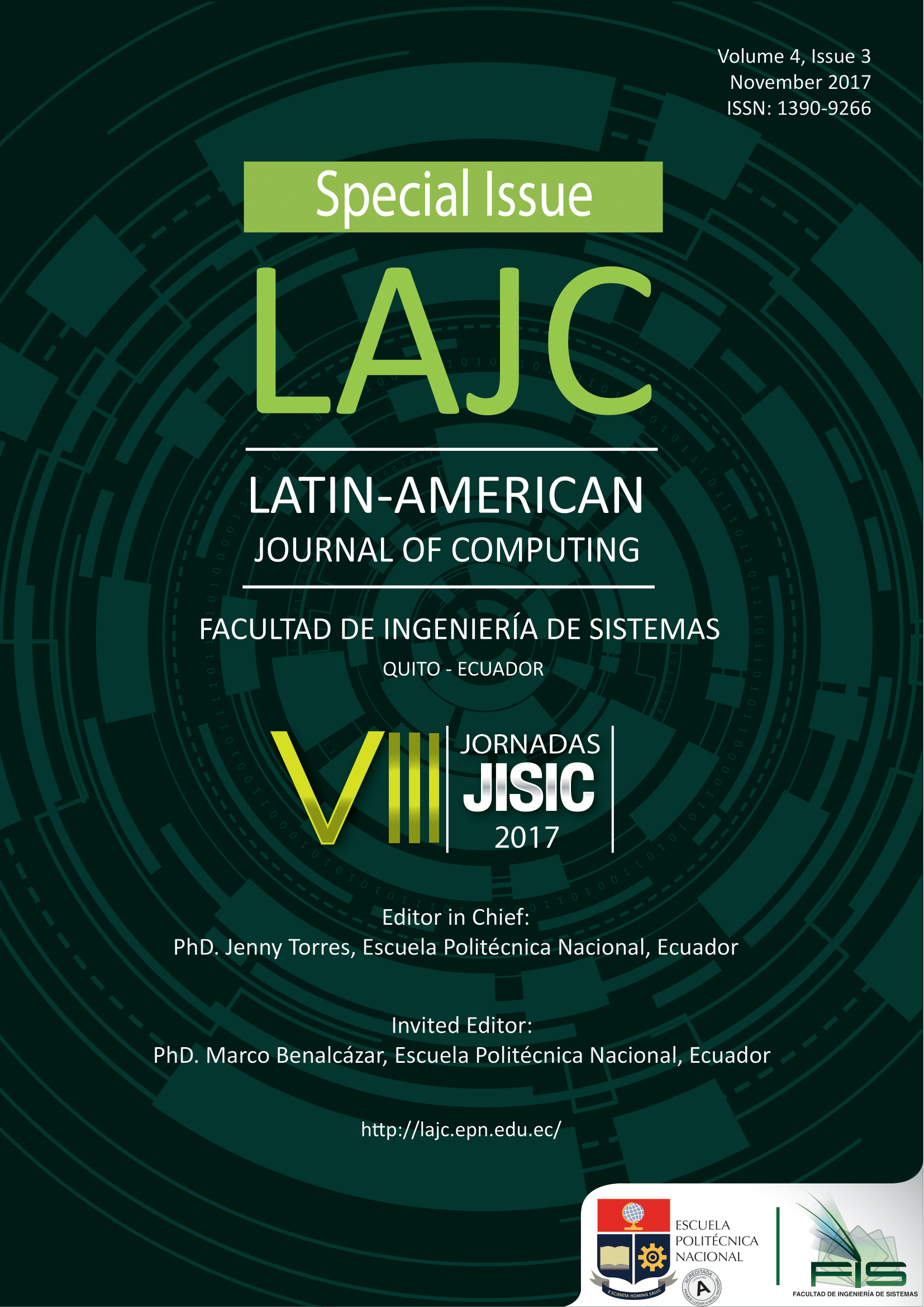Implementation of an Affective Model for MASOES
Palabras clave:
Multiagent System, Affective Computing, Affective Model, Emotional Interaction, MASOES.Resumen
Different authors seek to improve the interactionbetween intelligent agents in multi-agent systems, an example isthe affective model of MASOES, which through the generationof emotions promotes different types of behaviors. Although thisaffective model has been formally verified at the design level,it has not been verified at the implementation level. This workpresents methodologically the implementation for the affectivemodel of MASOES on a multiagent system, verifying the requiredat the design level by this multiagent architecture, in order toprovide an environment for the interaction between the emotionalprocesses and the different functions of an agent. In addition, wepropose the calculation of Social Emotion, allowing to describethe collective emotional state of a group of emotional agents.
Descargas
Referencias
J. Cuevas, “Emociones: calculemos. las promesas de la computaci ́onafectiva,” Master’s thesis, Universidad Nacional de Educación a Distancia, Facultad de Filosof ́ıa, Madrid, España, 2015.
L. Rodr ́ıguez and F. Ramos, “Computational models of emotions for autonomous agents: major challenges,”Artificial Intelligence Review,vol. 43, no. 3, pp. 437–465, 2015.
H. Jiang, J. Vidal, and M. Huhns, “EBDI: an architecture for emotional agents,” in Proceedings of the 6th international joint conference on Autonomous agents and multiagent systems. ACM, 2007, pp. 38–40.
N. Perozo, J. Aguilar, O. Terán, and H. Molina, “An affective model for the multiagent architecture for self-organizing and emergent systems (MASOES),”Revista Técnica de la Facultad de Ingeniería. Universidad del Zulia, vol. 35, no. 1, pp. 1–11, 2012.
——, “Self-organization and emergence phenomena in wikipedia and free software development using MASOES, ”Publicaciones en Ciencias y Tecnología. Universidad Centroccidental Lisandro Alvarado, vol. 7,no. 1, pp. 51–72, 2013.
A. Gil, J. Aguilar, R. Rivas, E. Dapena, and K. Hernandez, “Architecturefor multi-robot systems with emergent behavior,” in Proceedings on the International Conference on Artificial Intelligence (ICAI). The Steering Committee of The World Congress in Computer Science, ComputerEngineering and Applied Computing (WorldComp), 2015, pp. 41–47.
M. Dastani, C. Floor, and J.-J. C. Meyer, “Programming agents with emotions,” in Emotion Modeling. Springer, 2014, pp. 57–75.
N. Perozo, J. Aguilar, and O. Terán, “Proposal for a multiagent architecture for self-organizing systems (ma-sos),”Intelligence and SecurityInformatics, pp. 434–439, 2008.
N. Perozo, “Modelado multiagente para sistemas emergentes y auto-organizados,” Ph.D. dissertation, Universidad de los Andes, Mérida, Venezuela, 2011.
(2017, sep) Prolog website. [Online]. Available: http://www.swi-prolog.org/
D. Anthony, S. W. Smith, and T. Williamson, “Reputation and reliabilityin collective goods the case of the online encyclopedia wikipedia,”Rationality and Society, vol. 21, no. 3, pp. 283–306, 2009.
S. Javanmardi, Y. Ganjisaffar, C. Lopes, and P. Baldi, “User contributionand trust in wikipedia,” in5th International Conference on CollaborativeComputing: Networking, Applications and Worksharing.IEEE, 2009,pp. 1–6.
L. De Alfaro, A. Kulshreshtha, I. Pye, and B. T. Adler, “Reputation systems for open collaboration, ”Communications of the ACM, vol. 54,no. 8, pp. 81–87, 2011.
J. Rincon, V. Julian, and C. Carrascosa, “Social emotional model,” in Advances in Practical Applications of Agents, Multi-Agent Systems, and Sustainability: The PAAMS Collection. Springer, 2015, pp. 199–210.
(2017, sep) Jade website. [Online]. Available: http://jade.tilab.com/
Descargas
Publicado
Número
Sección
Licencia
Aviso de derechos de autor/a
Los autores/as que publiquen en esta revista aceptan las siguientes condiciones:
- Los autores conservan los derechos de autor y ceden a la revista el derecho de la primera publicación, con el trabajo registrado con la Creative Commons Attribution-Non-Commercial-Share-Alike 4.0 International, que permite a terceros utilizar lo publicado siempre que mencionen la autoría del trabajo y a la primera publicación en esta revista.
- Los autores pueden realizar otros acuerdos contractuales independientes y adicionales para la distribución no exclusiva de la versión del artículo publicado en esta revista (p. ej., incluirlo en un repositorio institucional o publicarlo en un libro) siempre que indiquen claramente que el trabajo se publicó por primera vez en esta revista.
- Se permite y recomienda a los autores a compartir su trabajo en línea (por ejemplo: en repositorios institucionales o páginas web personales) antes y durante el proceso de envío del manuscrito, ya que puede conducir a intercambios productivos, a una mayor y más rápida citación del trabajo publicado.
Descargo de Responsabilidad
LAJC en ningún caso será responsable de cualquier reclamo directo, indirecto, incidental, punitivo o consecuente de infracción de derechos de autor relacionado con artículos que han sido presentados para evaluación o publicados en cualquier número de esta revista. Más Información en nuestro Aviso de Descargo de Responsabilidad.










